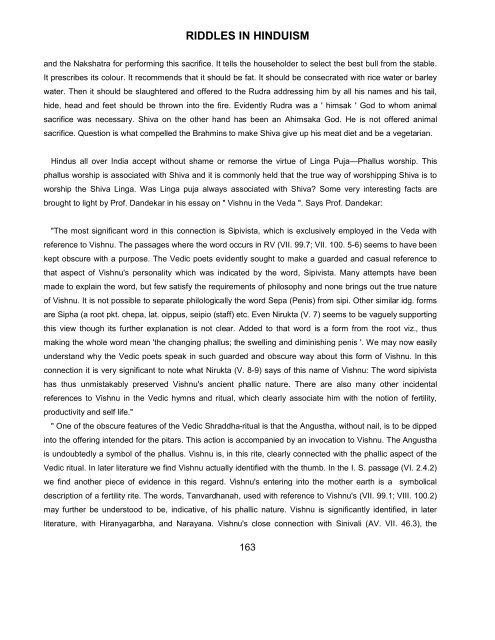You also want an ePaper? Increase the reach of your titles
YUMPU automatically turns print PDFs into web optimized ePapers that Google loves.
RIDDLES IN HINDUISM<br />
and the Nakshatra for perform<strong>in</strong>g this sacrifice. It tells the householder to select the best bull from the stable.<br />
It prescribes its colour. It recommends that it should be fat. It should be consecrated with rice water or barley<br />
water. Then it should be slaughtered and offered to the Rudra address<strong>in</strong>g him by all his names and his tail,<br />
hide, head and feet should be thrown <strong>in</strong>to the fire. Evidently Rudra was a ' himsak ' God to whom animal<br />
sacrifice was necessary. Shiva on the other hand has been an Ahimsaka God. He is not offered animal<br />
sacrifice. Question is what compelled the Brahm<strong>in</strong>s to make Shiva give up his meat diet and be a vegetarian.<br />
H<strong>in</strong>dus all over India accept without shame or remorse the virtue of L<strong>in</strong>ga Puja—Phallus worship. This<br />
phallus worship is associated with Shiva and it is commonly held that the true way of worshipp<strong>in</strong>g Shiva is to<br />
worship the Shiva L<strong>in</strong>ga. Was L<strong>in</strong>ga puja always associated with Shiva? Some very <strong>in</strong>terest<strong>in</strong>g facts are<br />
brought to light by Prof. Dandekar <strong>in</strong> his essay on " Vishnu <strong>in</strong> the Veda ". Says Prof. Dandekar:<br />
"The most significant word <strong>in</strong> this connection is Sipivista, which is exclusively employed <strong>in</strong> the Veda with<br />
reference to Vishnu. The passages where the word occurs <strong>in</strong> RV (VII. 99.7; VII. 100. 5-6) seems to have been<br />
kept obscure with a purpose. The Vedic poets evidently sought to make a guarded and casual reference to<br />
that aspect of Vishnu's personality which was <strong>in</strong>dicated by the word, Sipivista. Many attempts have been<br />
made to expla<strong>in</strong> the word, but few satisfy the requirements of philosophy and none br<strong>in</strong>gs out the true nature<br />
of Vishnu. It is not possible to separate philologically the word Sepa (Penis) from sipi. Other similar idg. forms<br />
are Sipha (a root pkt. chepa, lat. oippus, seipio (staff) etc. Even Nirukta (V. 7) seems to be vaguely support<strong>in</strong>g<br />
this view though its further explanation is not clear. Added to that word is a form from the root viz., thus<br />
mak<strong>in</strong>g the whole word mean 'the chang<strong>in</strong>g phallus; the swell<strong>in</strong>g and dim<strong>in</strong>ish<strong>in</strong>g penis '. We may now easily<br />
understand why the Vedic poets speak <strong>in</strong> such guarded and obscure way about this form of Vishnu. In this<br />
connection it is very significant to note what Nirukta (V. 8-9) says of this name of Vishnu: The word sipivista<br />
has thus unmistakably preserved Vishnu's ancient phallic nature. There are also many other <strong>in</strong>cidental<br />
references to Vishnu <strong>in</strong> the Vedic hymns and ritual, which clearly associate him with the notion of fertility,<br />
productivity and self life."<br />
" One of the obscure features of the Vedic Shraddha-ritual is that the Angustha, without nail, is to be dipped<br />
<strong>in</strong>to the offer<strong>in</strong>g <strong>in</strong>tended for the pitars. This action is accompanied by an <strong>in</strong>vocation to Vishnu. The Angustha<br />
is undoubtedly a symbol of the phallus. Vishnu is, <strong>in</strong> this rite, clearly connected with the phallic aspect of the<br />
Vedic ritual. In later literature we f<strong>in</strong>d Vishnu actually identified with the thumb. In the I. S. passage (VI. 2.4.2)<br />
we f<strong>in</strong>d another piece of evidence <strong>in</strong> this regard. Vishnu's enter<strong>in</strong>g <strong>in</strong>to the mother earth is a symbolical<br />
description of a fertility rite. The words, Tanvardhanah, used with reference to Vishnu's (VII. 99.1; VIII. 100.2)<br />
may further be understood to be, <strong>in</strong>dicative, of his phallic nature. Vishnu is significantly identified, <strong>in</strong> later<br />
literature, with Hiranyagarbha, and Narayana. Vishnu's close connection with S<strong>in</strong>ivali (AV. VII. 46.3), the<br />
163


















